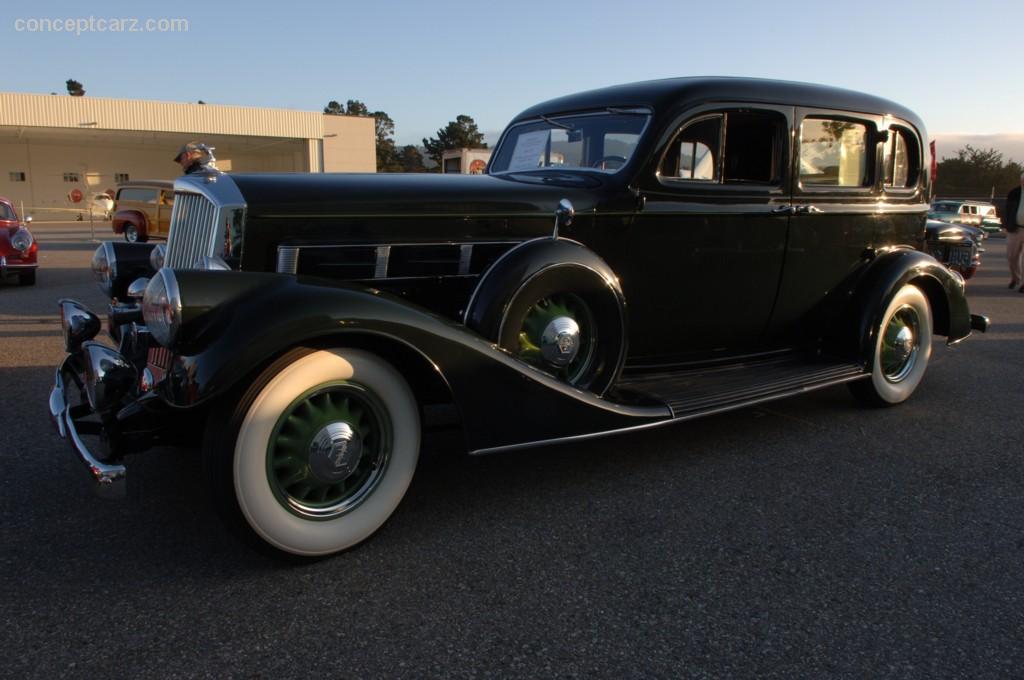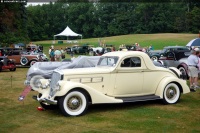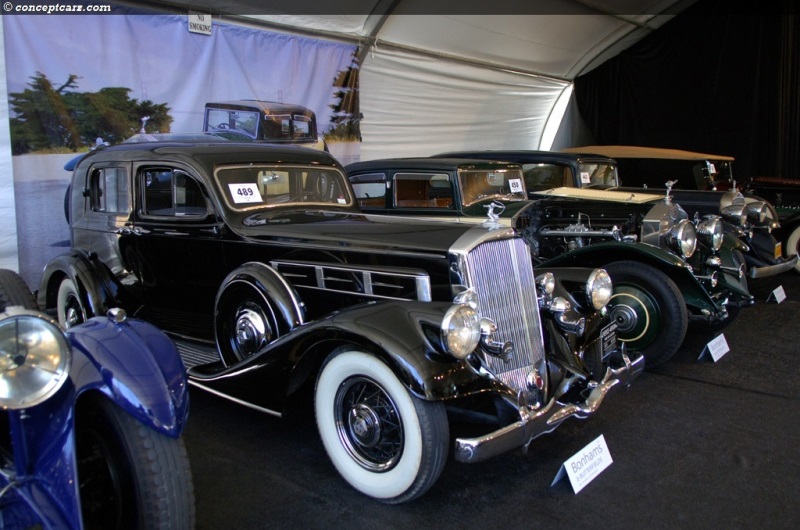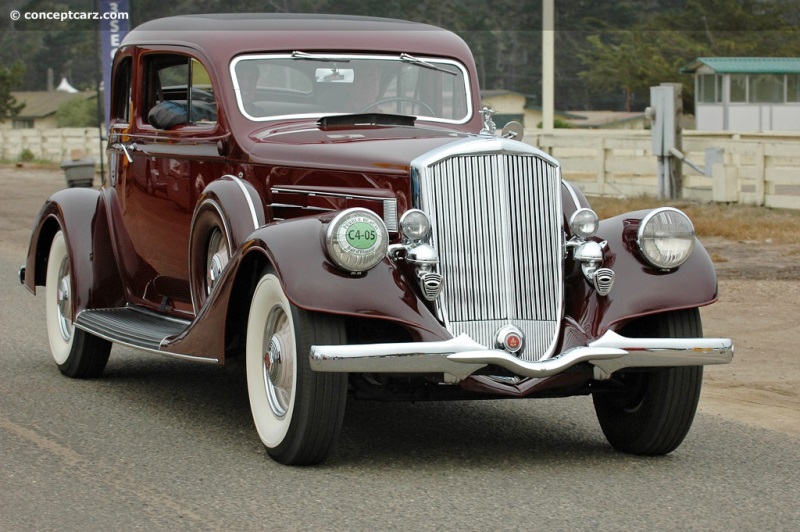Image credit: © conceptcarz.com (Reproduction Or reuse prohibited).
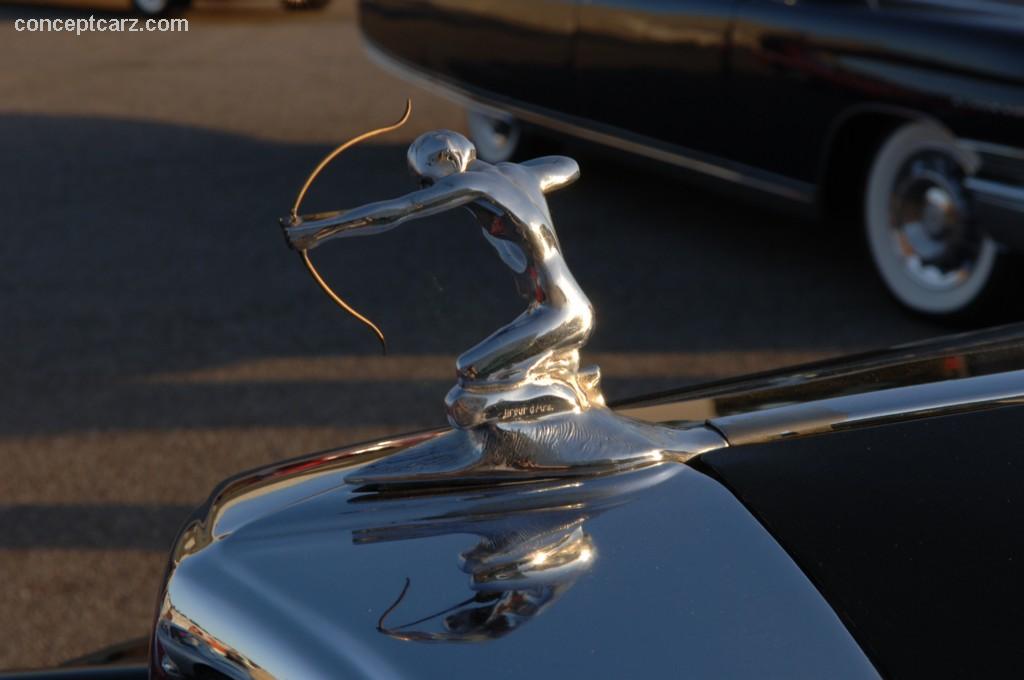
Before entering the automaking business in 1901, the George N. Pierce Company of Buffalo, New York had been engaged in making such diverse products as birdcages and bicycles. Pierce's first cars were called Motorettes and were powered by De Dion Bouton engines. By 1903 Pierce was building two-cylinder cars, with their Pierce Great Arrow four-cylinder cars arriving the following year. Great Arrow's model line of models expanded to include six-cylinder cars in 1907 and two years later the name was changed to Pierce-Arrow. Only the finest materials were used in these motor cars including complex but immensely strong cast aluminum bodies. Through the years Pierce also pioneered the use of power brakes and hydraulic tappets, and in 1913 the marque's most distinguishing feature first appeared when fender-mounted headlamps became standard on all series.
While the cars found great success and acceptance at the highest social and governmental levels (Pierce-Arrows were the official White House automobile for many years), perhaps Pierce's greatest mechanical tour de force in the early years was the gargantuan Model 66. With a rating of 60 horsepower and a 5 x 7 bore and stroke in its six cylinders, these road-going locomotives rode on a wheelbase of over twelve feet and cost anywhere from $6,500 to $8,000 depending on the body style specified by the well-heeled customer. The Dual Valve Six appeared in late 1918 and shortly afterward Pierce-Arrow went through several years of turmoil as company ownership as well as the engineering and executive staff went through some key changes. To expand its market Pierce brought out the Series 80 in 1924. This was a lower-priced and more modern-appearing car than the senior autos, but it was still a six-cylinder, as Pierce stubbornly clung to the credo that a six was the ideal powerplant. Meanwhile, the competition offered V and straight eights; Packard had even offered twelves during the early 1920s. It would not be until 1930 that Pierce brought out an eight-cylinder car, just in time to be trumped by the V12s and V16s of Cadillac, Marmon, and Lincoln. Nonetheless, it was a superb engine in the Pierce-Arrow tradition of thorough, proven engineering applied via the best materials and highest standards of manufacturing and workmanship. Pierce and Studebaker merged in 1929 although the Buffalo automaker remained an independent entity in terms of development and manufacturing. They played a quick and successful game of catch-up in the multi-cylinder race, bringing a new and magnificent V12 engine to market in late 1931. But the marriage to Studebaker was proving less than felicitous and in 1933 the South Bend firm went into receivership, taking Pierce-Arrow down with it. Their troubles continued for another year, but with the reorganization, the company was operating free of bankruptcy by May 1935. With the company focused on its financials, the design of the cars went relatively unchanged during these tumultuous times, with distinguishing features that emerged being the increased convexity of the headlight lenses, as well as the three hood doors arranged in a straight line.
This particular car rides on a 138-inch wheelbase and underwent a mechanical upgrade giving it a displacement of 400 cubic inches instead of 385. Despite being an older restoration this Pierce-Arrow has been attended to mechanically, which is experienced when you drive the car as it is a sheer joy to tour. With a tidy engine bay and undercarriage, it is clear that this car has been well looked after. The bodywork and shut lines are very straight, only showing signs of gentle use over time. Finished in a most attractive shade of dark green, the paintwork has aged graciously and still presents itself extremely well. The fabric interior has similarly held up quite well over the years, and with its period-correct green tone, the interior compliments the exterior finish of the car.
One could certainly be off and running knowing this later model Pierce-Arrow has enjoyed the attention and care to make it a pleasant and reliable tourer.Source - Christies
While the cars found great success and acceptance at the highest social and governmental levels (Pierce-Arrows were the official White House automobile for many years), perhaps Pierce's greatest mechanical tour de force in the early years was the gargantuan Model 66. With a rating of 60 horsepower and a 5 x 7 bore and stroke in its six cylinders, these road-going locomotives rode on a wheelbase of over twelve feet and cost anywhere from $6,500 to $8,000 depending on the body style specified by the well-heeled customer. The Dual Valve Six appeared in late 1918 and shortly afterward Pierce-Arrow went through several years of turmoil as company ownership as well as the engineering and executive staff went through some key changes. To expand its market Pierce brought out the Series 80 in 1924. This was a lower-priced and more modern-appearing car than the senior autos, but it was still a six-cylinder, as Pierce stubbornly clung to the credo that a six was the ideal powerplant. Meanwhile, the competition offered V and straight eights; Packard had even offered twelves during the early 1920s. It would not be until 1930 that Pierce brought out an eight-cylinder car, just in time to be trumped by the V12s and V16s of Cadillac, Marmon, and Lincoln. Nonetheless, it was a superb engine in the Pierce-Arrow tradition of thorough, proven engineering applied via the best materials and highest standards of manufacturing and workmanship. Pierce and Studebaker merged in 1929 although the Buffalo automaker remained an independent entity in terms of development and manufacturing. They played a quick and successful game of catch-up in the multi-cylinder race, bringing a new and magnificent V12 engine to market in late 1931. But the marriage to Studebaker was proving less than felicitous and in 1933 the South Bend firm went into receivership, taking Pierce-Arrow down with it. Their troubles continued for another year, but with the reorganization, the company was operating free of bankruptcy by May 1935. With the company focused on its financials, the design of the cars went relatively unchanged during these tumultuous times, with distinguishing features that emerged being the increased convexity of the headlight lenses, as well as the three hood doors arranged in a straight line.
This particular car rides on a 138-inch wheelbase and underwent a mechanical upgrade giving it a displacement of 400 cubic inches instead of 385. Despite being an older restoration this Pierce-Arrow has been attended to mechanically, which is experienced when you drive the car as it is a sheer joy to tour. With a tidy engine bay and undercarriage, it is clear that this car has been well looked after. The bodywork and shut lines are very straight, only showing signs of gentle use over time. Finished in a most attractive shade of dark green, the paintwork has aged graciously and still presents itself extremely well. The fabric interior has similarly held up quite well over the years, and with its period-correct green tone, the interior compliments the exterior finish of the car.
One could certainly be off and running knowing this later model Pierce-Arrow has enjoyed the attention and care to make it a pleasant and reliable tourer.Source - Christies
This 1935 Pierce-Arrow Model 845 Four-Door Sedan is a left-hand drive vehicle with a 400 cubic-inch eight-cylinder engine that produces 140 horsepower. Its three-speed manual gearbox sends power to the rear wheels while the four-wheel mechanical brakes provide the stopping power. It is dark green with a green interior. At the 2006 Christies Auction in Monterey, CA at the Jet Center it was expected to fetch between $45000-$65000. The lot with chassis number 2090110 was sold for $49350.
This vehicle sits on a 138-inch wheelbase and has undergone a mechanical upgrade which replaced the original 385 cubic-inch engine with a 400 cubic-inch unit.
George N. Pierce began producing automobiles in 1901. Prior to this, his talents were used for making everything from bicycles to birdcages. The first automobile by Pierce was the Motorettes and powered by a DeDion Bouton engine. Within a few years, the vehicles were powered by two cylinders. In 1904 the Pierce Great Arrow was introduced and its four-cylinder engine with stylish body and superior durability made it extremely popular and sought after. By 1907 Pierce raised the bar even further by offering the Great Arrows with six-cylinder engines. By 1909 the company had changed its name to Pierce-Arrow.
The bodies were comprised of cast aluminum and throughout the vehicle, only the finest materials could be found. The vehicles pioneered the use of power brakes and hydraulic tappets. They were elegant, powerful, reliable, and mechanically advanced. The designs were equally advanced. In 1913 the Pierce-Arrow continued to distinguish itself from the competition by incorporating fender-mounted headlamps which now came standard on all series. Perhaps the pinnacle of mechanical stature was the Model 66 which had a 60 horsepower six-cylinder engine and sat on a wheelbase that was in excess of twelve feet. The price tag was equally as impassive, setting the buyer back between $6500 to $8000.
After World War I the company experienced difficulties due to a variety of problems. In 1924 the company introduced the Series 80 which proved the versatility of the company. The competition had become very fierce for the high-priced automotive segment so Pierce had made the decision to create a lower-priced automobile that continued the company's reputation for elegance and reliability. It was powered by a six-cylinder engine.
The six-cylinder engine may have been part of the ultimate demise of the company. Other marques were offering larger eight-cylinder engines which Pierce was stubborn and felt that the six-cylinder engine was more than adequate. As a result, the competition continued to improve and expanded its clientele base. By 1930 Pierce was playing 'catch-up' as they poured much money and resources into the development of an eight-cylinder engine. Once again, they were a few years too late as many marques introduced twelve-cylinder units. Within a few years, Cadillac and Marmon shocked the world with their impressive sixteen-cylinder engines that were far superior to the rest of the market.
The Pierce eight was a technically advanced engine in all respects. It was outfitted with the best materials and built to high standards and workmanship. By 1931 Pierce had introduced a twelve-cylinder engine and was again a player in the multi-cylinder race.
A union with the Studebaker Company was expected to help during the hard times brought on by the Great Depression. The union would prove to be a failure and by 1933 the Pierce-Arrow Company entered receivership. The company was reorganized and by May of 1935 was free of bankruptcy. The company focused on generating revenue for the struggling company. In an effort to cut costs, there was little development and few new designs for the next few years.
The Packard Company was managing to stay afloat by creating a lower-cost line that appealed to a broader market segment and had increased revenue and sales. Pierce-Arrow attempted to mimic their achievement by introducing the low-priced One-Twenty model. The move may have worked if it had been done earlier, and Pierce-Arrow was forced to cease production in 1938. On Friday, May 13th the company was sold at auction.By Daniel Vaughan | Apr 2008
This vehicle sits on a 138-inch wheelbase and has undergone a mechanical upgrade which replaced the original 385 cubic-inch engine with a 400 cubic-inch unit.
George N. Pierce began producing automobiles in 1901. Prior to this, his talents were used for making everything from bicycles to birdcages. The first automobile by Pierce was the Motorettes and powered by a DeDion Bouton engine. Within a few years, the vehicles were powered by two cylinders. In 1904 the Pierce Great Arrow was introduced and its four-cylinder engine with stylish body and superior durability made it extremely popular and sought after. By 1907 Pierce raised the bar even further by offering the Great Arrows with six-cylinder engines. By 1909 the company had changed its name to Pierce-Arrow.
The bodies were comprised of cast aluminum and throughout the vehicle, only the finest materials could be found. The vehicles pioneered the use of power brakes and hydraulic tappets. They were elegant, powerful, reliable, and mechanically advanced. The designs were equally advanced. In 1913 the Pierce-Arrow continued to distinguish itself from the competition by incorporating fender-mounted headlamps which now came standard on all series. Perhaps the pinnacle of mechanical stature was the Model 66 which had a 60 horsepower six-cylinder engine and sat on a wheelbase that was in excess of twelve feet. The price tag was equally as impassive, setting the buyer back between $6500 to $8000.
After World War I the company experienced difficulties due to a variety of problems. In 1924 the company introduced the Series 80 which proved the versatility of the company. The competition had become very fierce for the high-priced automotive segment so Pierce had made the decision to create a lower-priced automobile that continued the company's reputation for elegance and reliability. It was powered by a six-cylinder engine.
The six-cylinder engine may have been part of the ultimate demise of the company. Other marques were offering larger eight-cylinder engines which Pierce was stubborn and felt that the six-cylinder engine was more than adequate. As a result, the competition continued to improve and expanded its clientele base. By 1930 Pierce was playing 'catch-up' as they poured much money and resources into the development of an eight-cylinder engine. Once again, they were a few years too late as many marques introduced twelve-cylinder units. Within a few years, Cadillac and Marmon shocked the world with their impressive sixteen-cylinder engines that were far superior to the rest of the market.
The Pierce eight was a technically advanced engine in all respects. It was outfitted with the best materials and built to high standards and workmanship. By 1931 Pierce had introduced a twelve-cylinder engine and was again a player in the multi-cylinder race.
A union with the Studebaker Company was expected to help during the hard times brought on by the Great Depression. The union would prove to be a failure and by 1933 the Pierce-Arrow Company entered receivership. The company was reorganized and by May of 1935 was free of bankruptcy. The company focused on generating revenue for the struggling company. In an effort to cut costs, there was little development and few new designs for the next few years.
The Packard Company was managing to stay afloat by creating a lower-cost line that appealed to a broader market segment and had increased revenue and sales. Pierce-Arrow attempted to mimic their achievement by introducing the low-priced One-Twenty model. The move may have worked if it had been done earlier, and Pierce-Arrow was forced to cease production in 1938. On Friday, May 13th the company was sold at auction.By Daniel Vaughan | Apr 2008
No auction information available for this vehicle at this time.
1935 Pierce-Arrow 845 Auction Sales
Recent Sales of the Pierce-Arrow 845
(Data based on Model Year 1935 sales)
| 1935 Pierce-Arrow 845 Silver Arrow Chassis#: 2590016 Sold for USD$103,040 2023 Worldwide Auctioneers : The Enthusiast Auction | |
| 1935 Pierce-Arrow 845 Sedan Chassis#: 238S442 Sold for USD$28,600 2017 The Auburn Auction : Worldwide Auctioneers | |
| 1935 Pierce-Arrow Model 845 Coupe Sold for USD$68,750 2014 Auctions America : California | |
| 1935 Pierce-Arrow Sedan Sold for USD$27,000 2014 Mecum - Kissimmee | |
| 1935 Pierce-Arrow 845 Three-Window Coupe Sold for USD$275,000 2013 Worldwide - The Houston Classic | |
| 1935 Pierce-Arrow Model 845 Rumble Seat Coupe Chassis#: 2090304 Sold for USD$41,660 2012 Bonhams - Collectors' Motor cars and Automobilia | |
| 1935 Pierce-Arrow 845 Formal Sedan Sold for USD$74,250 2008 Collector Cars of Fort Lauderdale | |
| 1935 Pierce Arrow 845 Sold for USD$46,000 2007 Bonhams, An Important Sale of Collectors' Motorcars and Automobilia |   |
Pierce-Arrow 845s That Failed To Sell At Auction
1935 Pierce-Arrow 845's that have appeared at auction but did not sell.
| Vehicle | Chassis | Event | High Bid | Est. Low | Est. High |
|---|
Vehicles With Comparable Market Values
Similar sales to the $83,038 range.
| 1969 CHEVROLET CAMARO Z/28 Chassis#:124379N690698 Sold for $82,500 2024 Barrett-Jackson : Palm Beach | |
| 1972 CHEVROLET CHEVELLE MALIBU CUSTOM COUPE Chassis#:1D37F2R508459 Sold for $82,500 2024 Barrett-Jackson : Palm Beach | |
| 1957 CHEVROLET CORVETTE 283/250 FUELIE CONVERTIBLE Chassis#:E57S104147 Sold for $82,500 2024 Barrett-Jackson : Palm Beach | |
| 1972 PLYMOUTH DUSTER Chassis#:VS29H2B472937 Sold for $82,500 2024 Barrett-Jackson : Palm Beach | |
| 1971 Chevrolet Blazer Chassis#:ke181s620713 Sold for $82,500 2024 Mecum : Houston | |
| 2021 Chevrolet Corvette Coupe Chassis#:1g1yb2d47m5117503 Sold for $82,500 2024 Mecum : Houston | |
| 1969 Chevrolet Camaro RS/SS Chassis#:124379n636993 Sold for $82,500 2024 Mecum : Houston | |
| 1966 Chevrolet Chevelle Chassis#:135176f145465 Sold for $82,500 2024 Mecum : Houston | |
| 1966 Chevrolet C10 Custom Pickup Chassis#:c1446a172883 Sold for $82,500 2024 Mecum : Houston | |
| 1969 Chevrolet C10 Pickup Chassis#:ce149b849022 Sold for $83,600 2024 Mecum : Houston | |
| 2017 Bentley Bentayga Chassis#:sjaac2zv5hc015160 Sold for $82,500 2024 Mecum : Houston | |
| 1971 Chevrolet C10 Cheyenne Pickup Chassis#:ce141f833192 Sold for $82,500 2024 Mecum : Houston | |
| 2012 Ferrari California Chassis#:zff65lja3c0185171 Sold for $82,500 2024 Mecum : Glendale | |
| 1969 Mercedes-Benz 280SL Convertible Chassis#:11304412009769 Sold for $82,500 2024 Mecum : Glendale | |
| 1970 GMC Custom Pickup Chassis#:ce134zz54863 Sold for $82,500 2024 Mecum : Glendale | |
| 1972 Porsche 911T Targa Chassis#:91121111481 Sold for $82,500 2024 Mecum : Glendale | |
| 1972 Chevrolet C10 Cheyenne Pickup Chassis#:cce142s199321 Sold for $82,500 2024 Mecum : Glendale | |
| 1972 Oldsmobile 442 Convertible Chassis#:3j67h2m139820 Sold for $82,500 2024 Mecum : Glendale | |
| 1968 Chevrolet Camaro Z28 Chassis#:124378n400300 Sold for $82,500 2024 Mecum : Glendale | |
| 2023 Dodge Challenger Mopar 23 Special Edition Chassis#:2c3cdzfj4ph677925 Sold for $82,500 2024 Mecum : Glendale |
1935 Pierce-Arrow 845
• Additional valuation insight and sales data• History
• Specifications
• Image gallery
